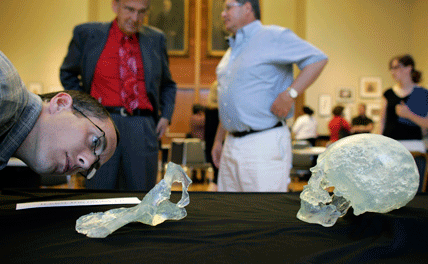A news reporter observes plastic replicas of the hip and skull of Kennewick Man in Seattle, Washington, on July 14, 2005.
A hot topic among archaeologists is the question, Just who were the Americas’ first inhabitants? Last fall the largest gathering of researchers of its kind in 15 years met in Santa Fe, New Mexico. At the Paleoamerican Odyssey Conference, evidence from archaeological sites throughout North, Central, and South America was presented, and a clear trend emerged: “Clovis” is no longer king. Clovis refers to the culture that existed near Clovis, New Mexico, where distinctive stone tools were unearthed in the 1920s and 1930s that pointed to human habitation some 12,000 years ago. Archaeologists developed the theory that humans reached the site near the end of the last ice age by migrating from northeastern Asia across a land bridge (Beringia) and trekking southward along an ice-free corridor. These pioneers and their descendants then spread throughout the vast unpopulated lands, eventually reaching southernmost South America.
So goes the reigning theory—now dethroned. The “Clovis first” theory has unraveled owing to discoveries throughout the Americas—from Monte Verde in Chile, Huaca Prieta in northern Peru, and Serra da Capivara National Park in central Brazil to Gault in central Texas and Paisley Caves in southern Oregon—that point to a human presence thousands of years earlier. Althourh nearly all archaeologists agree that the Clovis people were the ancestors of Native Americans, the emerging consensus about when humans arrived has shifted to earlier than previously thought. These migrants likely came by routes other than the land bridge and ice-free corridor, and may not have traveled overland at all. Rather, as some archaeologists propose, the earliest Americans may have skirted the northern Pacific coastline in boats. Others conjecture that humans reached North America from southwestern Europe, or South America from Africa.
Now into this wide-open field of conjecture “walks” Kennewick Man, the skeletal remains of an individual at least 9,000 years old. Called the “most important human skeleton ever found in North America,” it was found in the mud along the Columbia River in 1996 but was tied up by a legal controversy for more than a decade. Once archaeologists were finally able to examine Kennewick Man, they established clues to the skeleton’s story: DNA tests revealed that he was unrelated to any known Native American peoples living today.
Image credit: © Harley Soltes/The New York Times
Related Links
- The Kennewick Man Finally Freed to Share His Secrets
This article focuses on Kennewick Man, the skeleton whose discovery has helped overturn the prevailing theory about the peopling of the Americas.
(Source: Smithsonian Magazine, September 2014) - America, in the Beginning
This article provides background on the competing theories of the peopling of the Americas.
(Source: Archaeology, August 11, 2014) - Ancient Migration: Coming to America
This article focuses on the overturning of the prevailing Beringia land bridge theory of the peopling of the Americas.
(Source: Nature, May 3, 2012) - Making a Monkey Out of Early Peopling of the Americas
This blog by an anthropologist explores the stubbornness that underlies skepticism toward some research into the early peopling of the Americas—that is, findings that suggest human occupation occurred first in South America rather than North.
(Source: Psychology Today, March 29, 2014) - Origins of the Clovis People
This brief video presents the discovery of “Clovis points” in the eastern United States, and how they lend support to an alternative theory of the peopling of the Americas.
(Source: History.com; accessed June 23, 2016)




